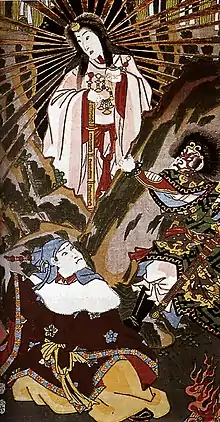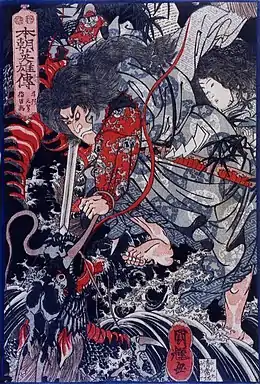Fudoki
Fudoki (風土記) are ancient reports on provincial culture, geography, and oral tradition presented to the reigning monarchs of Japan, also known as local gazetteers. They contain agricultural, geographical, and historical records as well as mythology and folklore.[1] Fudoki manuscripts also document local myths, rituals, and poems that are not mentioned in the Kojiki and the Nihon Shoki chronicles, which are the most important literature of the ancient national mythology and history. In the course of national unification, the imperial court enacted a series of criminal and administrative codes called ritsuryō and surveyed the provinces established by such codes to exert greater control over them.[2]
| Part of a series on |
| Shinto |
|---|
 |
| Practices and beliefs |
| Shinto shrines |
| Notable Kami |
| Important literature |
|
| See also |
Kofudoki
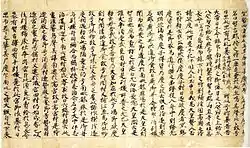
In the narrower sense, Fudoki refer to the oldest records written in the Nara period, later called Kofudoki (古風土記) (Old-Fudoki). Compilation of Kofudoki began in 713 and was completed over a 20-year period.[1] Following the Taika Reform in 646 and the Code of Taihō enacted in 701, there was need to centralize and solidify the power of the imperial court. This included accounting for lands under its control. According to the Shoku Nihongi, Empress Genmei issued a decree in 713 ordering each provincial government (ja:国衙, kokuga) to collect and report the following information:[1][3]
- Names of districts and townships
- Natural resources and living things
- Land fertility
- Etymology of names for geographic features, such as mountains, plains, and rivers
- Myths, legends, and folktales told orally by old people
Names
Empress Genmei ordered in 713 that place names in the provinces, districts, and townships be written in two kanji characters with positive connotations.[4][1] This occasionally required name changes. For example, Hayatsuhime (速津媛) became Hayami (速見) and Ishinashi no Oki (無石堡) became Ishii (石井).
Manuscripts
At least 48 of the Gokishichidō provinces contributed to their records but only that of Izumo remains nearly complete. Partial records of Hizen, Bungo, Harima and Hitachi remain and a few passages from various volumes remain scattered throughout various books.[1] Those of Harima and Hizen are designated National Treasures.
Below is a list of extant manuscripts and scattered passages.[5][6]
Kinai
Tōkaidō
Tōsandō
|
Hokurikudō
San'indō
San'yōdō
|
Nankaidō
Saikaidō
|
Parks
In 1966 the Agency for Cultural Affairs called on the prefectural governments to build open-air museums and parks called Fudoki no Oka (風土記の丘, "Fudoki Hills") near historic sites such as tombs (kofun) and provincial temples.[7] These archaeological museums preserve and exhibit cultural properties to enhance public understanding of provincial history and culture.
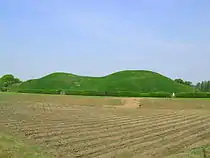
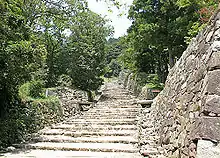
| Name | Prefecture | Province | Municipalities | Museum |
|---|---|---|---|---|
| Ukitamu Fudoki no Oka | Yamagata | Uzen | Takahata | Yamagata Prefectural Ukitama Fudoki no Oka Archaeological Museum |
| Shimotsuke Fudoki no Oka | Tochigi | Shimotsuke | Shimotsuke | Tochigi Prefectural Shimotsuke Fudoki no Oka Museum |
| Nasu Fudoki no Oka | Tochigi | Shimotsuke | Nakagawa and Ōtawara | Nakagawa Municipal Nasu Fudoki no Oka Museum |
| Sakitama Fudoki no Oka | Saitama | Musashi | Gyōda | Saitama Prefectural Museum of the Sakitama Ancient Burial Mounds |
| Chiba Prefectural Boso-no-Mura | Chiba | Shimōsa | Sakae and Narita | Boso-no-Mura Museum |
| Tateyama Fudoki no Oka | Toyama | Etchū | Tateyama | Toyama Prefectural Tateyama Museum |
| Kai Fudoki no Oka | Yamanashi | Kai | Kōfu | Yamanashi Prefectural Archaeological Museum |
| Ōmi Fudoki no Oka | Shiga | Ōmi | Ōmihachiman and Azuchi | Shiga Prefectural Azuchi Castle Archaeological Museum |
| Chikatsu Asuka Fudoki no Oka | Osaka | Kawachi | Kanan | Osaka Prefectural Chikatsu Asuka Museum |
| Kii Fudoki no Oka | Wakayama | Kii | Wakayama | Wakayama Prefecture Kii-fudoki-no-oka Museum of Archaeology and Folklore |
| Yakumotatsu Fudoki no Oka | Shimane | Izumo | Matsue | Shimane Prefectural Yakumotatsu Fudoki no Oka Museum |
| Kibiji Fudoki no Oka | Okayama | Bitchū | Sōja | Sōja Kibiji Museum |
| Miyoshi Fudoki no Oka | Hiroshima | Bingo | Miyoshi | Hiroshima Prefectural Miyoshi Fudoki no Oka Museum |
| Higo Kodai no Mori | Kumamoto | Higo | Yamaga and Nagomi | Kumamoto Prefectural Ancient Burial Mound Museum |
| Usa Fudoki no Oka | Ōita | Bungo | Usa | Ōita Prefectural Museum of History |
| Saitobaru Fudoki no Oka | Miyazaki | Hyūga | Saito | Miyazaki Prefectural Saitobaru Archaeological Museum |
See also
Notes
- Sakamoto 2011, pp. 16-17.
- Sakamoto 2011, pp. 4-5.
- Kojima et al. 2007, pp. 310-311.
- "好字令 (good names)". Collaborative Reference Database. National Diet Library. Retrieved 28 August 2015.
- Sakamoto 2011, p. 19.
- 国土としての始原史~風土記逸文 Archived 2013-01-04 at Archive.today
- Sakamoto 2011.
References
- Akimoto, Kichirō (1958). Nihon Koten Bungaku Taikei 2: Fudoki. Tōkyō: Iwanami Shoten. ISBN 4-00-060002-8.
- Sakamoto, Masaru (2011). Zusetsu Chizu to Arasuji de Wakaru! Fudoki. Seishun Publishing. ISBN 978-4-413-04301-4.
- Kojima, Noriyuki; Naoki, Kōjirō; Nishimiya, Kazutami; Kuranaka, Susumu; Mōri, Masamori; Uegaki, Setsuya (2007). Nihon no Koten wo Yomu 3 Nihon Shoki Ge • Fudoki. Shogakukan. ISBN 978-4-09-362173-1.
External links
- 風土記(Big5 Chinese) texts of the remaining Fudoki & scattered passages in other books.
- Manuscript scans at Waseda University Library: Hizen, 1800,Bungo, 1800, Bungo, unknown
- Tsukamoto, Tetsuzō (塚本 哲三) (1915). Kojiki, Norito, Fudoki (古事記・祝詞・風土記). Yūhōdō Shoten (有朋堂書店). pp. 383–586. Scan at the Internet Archive.
- 風土記 (in Japanese)
- 国土としての始原史~風土記逸文 (in Japanese)
